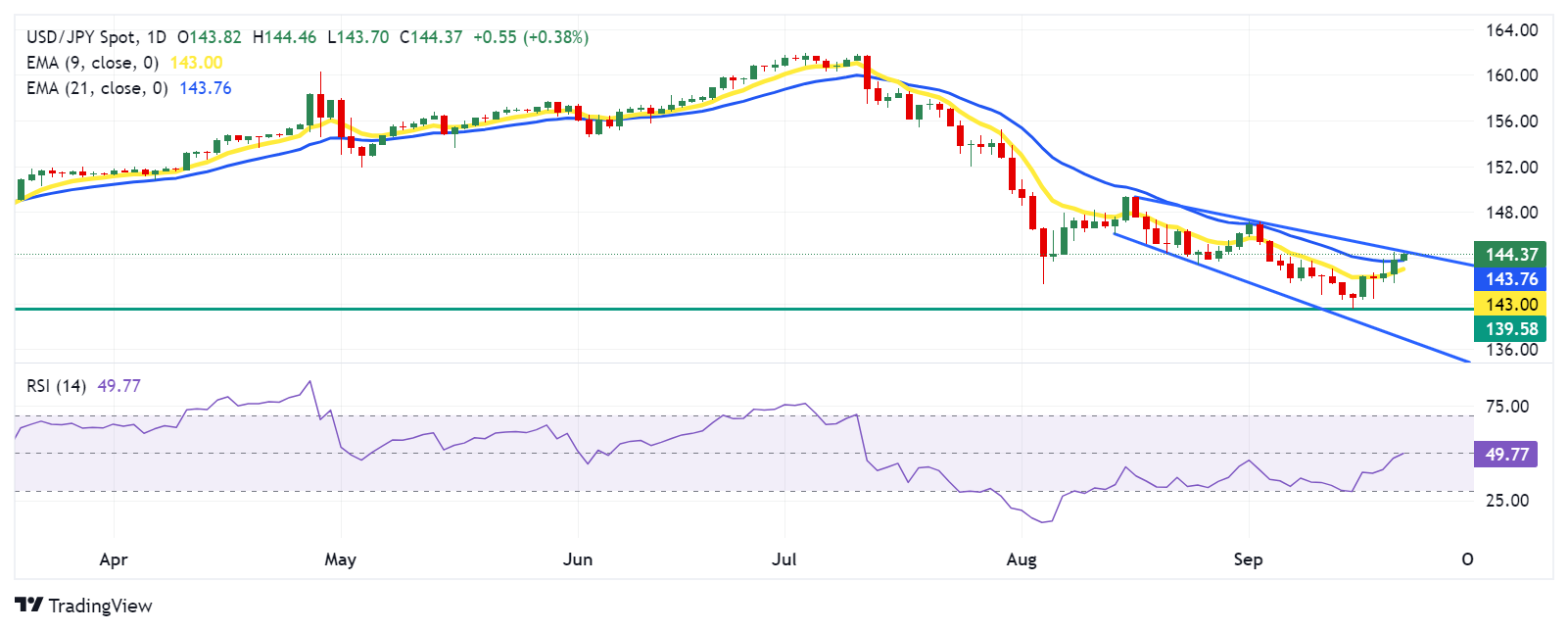- The Japanese Yen recovers its daily losses despite a solid US Dollar.
- BoJ Governor Ueda stated that the central bank will continue to adjust the level of monetary easing as needed.
- CME FedWatch Tool suggests a 50% odds of cutting 75 basis points by the Fed to a range of 4.0-4.25% by the end of this year.
The Japanese Yen (JPY) recovers its intraday losses amid holiday-thinned trading on Monday. This downward movement may be influenced by growing concerns that the Bank of Japan (BoJ) is not in a rush to raise interest rates.
The Bank of Japan maintained its interest rate target in the range of 0.15-0.25% at Friday’s meeting. BoJ Governor Kazuo Ueda emphasized that the central bank "will continue to adjust the level of monetary easing as needed to achieve our economic and inflation targets." Ueda acknowledged that while Japan's economy is showing moderate recovery, there are still signs of underlying weakness.
The US Dollar (USD) continues to rise as Treasury yields recover their losses. However, the Greenback may encounter challenges due to growing expectations for additional rate cuts by the US Federal Reserve (Fed) in 2024. According to the CME FedWatch Tool, markets are pricing in a 50% chance of 75 basis points to be deducted by the Fed to a range of 4.0-4.25% by the end of this year. Traders await US Purchasing Managers Index (PMI) data scheduled for release later in the North American session.
Daily Digest Market Movers: Japanese Yen struggles due to concerns of BoJ delaying rate hikes
- Japan's new "top currency diplomat," Atsushi Mimura, stated in an interview with NHK that the Yen carry trades accumulated in the past have likely been mostly unwound. Mimura cautioned that if such trades were to increase again, it could lead to heightened market volatility. "We are always monitoring the markets to ensure that does not happen," he added.
- On Friday, Philadelphia Fed President Patrick Harker stated that the US central bank has effectively steered through a challenging economic landscape in recent years. Harker compared monetary policy to driving a bus, where it's essential to balance speed.
- Japan’s Finance Minister Shunichi Suzuki stated on Friday that he “will continue to monitor and analyze the impact of the latest US rate cut on the Japanese economy and financial markets.” Suzuki added that the Federal Reserve Bank’s (FRB) perspective on the US economy aligns with the Japanese government's view that the US economy is likely to expand.
- Japan's Consumer Price Index (CPI) increased to 3.0% year-on-year in August, up from 2.8% previously, marking the highest level since October 2023. Additionally, the Core National CPI, excluding fresh food, reached a six-month high of 2.8%, rising for the fourth consecutive month and in line with market expectations.
- The Federal Open Market Committee (FOMC) lowered the federal funds rate to a range of 4.75% to 5.0%, marking the Fed’s first rate cut in over four years. Fed policymakers updated their quarterly economic forecasts, increasing the median projection for unemployment to 4.4% by the end of 2024, up from the 4.0% estimate made in June. They also raised their long-term forecast for the federal funds rate from 2.8% to 2.9%.
- Federal Reserve Chair Jerome Powell commented on the aggressive 50 basis point rate cut, saying, “This decision reflects our increased confidence that, with the right adjustments to our policy approach, we can maintain a strong labor market, achieve moderate economic growth, and bring inflation down to a sustainable 2% level.”
- Japan’s Merchandise Trade Balance Total recorded a larger trade deficit of ¥695.30 billion in August, up from ¥628.70 billion the previous month, but well below market expectations of a ¥1,380.0 billion shortfall. Exports increased by 5.6% year-over-year, marking the ninth consecutive month of growth, but fell short of the anticipated 10.0%. Imports rose by just 2.3%, the slowest pace in five months, significantly underperforming the projected 13.4% rise.
Technical Analysis: USD/JPY tests 144.50 near the upper boundary of the descending channel
USD/JPY trades around 144.40 on Monday. The daily chart analysis shows that the pair is moving higher within a descending channel. A break above the upper level of the channel would lead to a momentum shift from bearish to bullish bias. Additionally, the 14-day Relative Strength Index (RSI) is slightly below the 50 level. A break above this threshold could signal the emergence of bullish sentiment.
On the upside, the immediate resistance appears at the upper boundary of the descending channel around the 144.70 level. A breakthrough above this level could support the USD/JPY pair to test the psychological level of the 145.00.
On the downside, the USD/JPY pair could test the 21-day Exponential Moving Average (EMA) at the 143.76 level, followed by the nine-day EMA at the 143.00 level. A break below the latter could push the pair to revisit the 139.58, which is the lowest level since June 2023.
USD/JPY: Daily Chart
Japanese Yen PRICE Today
The table below shows the percentage change of Japanese Yen (JPY) against listed major currencies today. Japanese Yen was the strongest against the Euro.
| USD | EUR | GBP | JPY | CAD | AUD | NZD | CHF | |
|---|---|---|---|---|---|---|---|---|
| USD | 0.62% | 0.38% | -0.26% | 0.06% | -0.09% | -0.06% | 0.12% | |
| EUR | -0.62% | -0.29% | -0.86% | -0.55% | -0.77% | -0.66% | -0.51% | |
| GBP | -0.38% | 0.29% | -0.51% | -0.25% | -0.48% | -0.37% | -0.22% | |
| JPY | 0.26% | 0.86% | 0.51% | 0.32% | 0.08% | 0.22% | 0.26% | |
| CAD | -0.06% | 0.55% | 0.25% | -0.32% | -0.09% | -0.12% | 0.04% | |
| AUD | 0.09% | 0.77% | 0.48% | -0.08% | 0.09% | 0.12% | 0.25% | |
| NZD | 0.06% | 0.66% | 0.37% | -0.22% | 0.12% | -0.12% | 0.15% | |
| CHF | -0.12% | 0.51% | 0.22% | -0.26% | -0.04% | -0.25% | -0.15% |
The heat map shows percentage changes of major currencies against each other. The base currency is picked from the left column, while the quote currency is picked from the top row. For example, if you pick the Japanese Yen from the left column and move along the horizontal line to the US Dollar, the percentage change displayed in the box will represent JPY (base)/USD (quote).
Japanese Yen FAQs
The Japanese Yen (JPY) is one of the world’s most traded currencies. Its value is broadly determined by the performance of the Japanese economy, but more specifically by the Bank of Japan’s policy, the differential between Japanese and US bond yields, or risk sentiment among traders, among other factors.
One of the Bank of Japan’s mandates is currency control, so its moves are key for the Yen. The BoJ has directly intervened in currency markets sometimes, generally to lower the value of the Yen, although it refrains from doing it often due to political concerns of its main trading partners. The current BoJ ultra-loose monetary policy, based on massive stimulus to the economy, has caused the Yen to depreciate against its main currency peers. This process has exacerbated more recently due to an increasing policy divergence between the Bank of Japan and other main central banks, which have opted to increase interest rates sharply to fight decades-high levels of inflation.
The BoJ’s stance of sticking to ultra-loose monetary policy has led to a widening policy divergence with other central banks, particularly with the US Federal Reserve. This supports a widening of the differential between the 10-year US and Japanese bonds, which favors the US Dollar against the Japanese Yen.
The Japanese Yen is often seen as a safe-haven investment. This means that in times of market stress, investors are more likely to put their money in the Japanese currency due to its supposed reliability and stability. Turbulent times are likely to strengthen the Yen’s value against other currencies seen as more risky to invest in.
Information on these pages contains forward-looking statements that involve risks and uncertainties. Markets and instruments profiled on this page are for informational purposes only and should not in any way come across as a recommendation to buy or sell in these assets. You should do your own thorough research before making any investment decisions. FXStreet does not in any way guarantee that this information is free from mistakes, errors, or material misstatements. It also does not guarantee that this information is of a timely nature. Investing in Open Markets involves a great deal of risk, including the loss of all or a portion of your investment, as well as emotional distress. All risks, losses and costs associated with investing, including total loss of principal, are your responsibility. The views and opinions expressed in this article are those of the authors and do not necessarily reflect the official policy or position of FXStreet nor its advertisers. The author will not be held responsible for information that is found at the end of links posted on this page.
If not otherwise explicitly mentioned in the body of the article, at the time of writing, the author has no position in any stock mentioned in this article and no business relationship with any company mentioned. The author has not received compensation for writing this article, other than from FXStreet.
FXStreet and the author do not provide personalized recommendations. The author makes no representations as to the accuracy, completeness, or suitability of this information. FXStreet and the author will not be liable for any errors, omissions or any losses, injuries or damages arising from this information and its display or use. Errors and omissions excepted.
The author and FXStreet are not registered investment advisors and nothing in this article is intended to be investment advice.
Recommended content
Editors’ Picks

AUD/USD retakes 0.6000 on the road to recovery amid US-China trade war
AUD/USD is off the five-year low but remains heavy near 0.6000 in the Asian session on Monday. The pair continues to suffer from a US-China trade war as US President Trump said that he would not do a deal with China until the US trade deficit was sorted out.

USD/JPY attempts tepid recovery above 146.00
USD/JPY kicks off the new week on a weaker note, though it manages to stage a tepid recovery above 146.00 early Monday. The global carnage, amid the mounting risk of a recession and a trade war led by Trump's sweeping tariffs, keeps the safe-haven Japanese Yen underpinned at the expense of the US Dollar.

Gold buyers refuse to give up amid global trade war and recession risks
Gold price is holding the quick turnaround from one-month lows of $2,971, consolidating the recent downward spiral. The extension of the risk-off market profile into Asia this Monday revives the safe-haven demand for Gold price.

Bitcoin could be the winner in the ongoing trade war after showing signs of decoupling from stocks
Bitcoin traded above $84,000 on Friday, showing strength despite the stock market experiencing significant declines. The market reaction stems from United States President Donald Trump's clash with the Federal Reserve Chairman Jerome Powell over interest rate decisions.

Strategic implications of “Liberation Day”
Liberation Day in the United States came with extremely protectionist and inward-looking tariff policy aimed at just about all U.S. trading partners. In this report, we outline some of the more strategic implications of Liberation Day and developments we will be paying close attention to going forward.

The Best brokers to trade EUR/USD
SPONSORED Discover the top brokers for trading EUR/USD in 2025. Our list features brokers with competitive spreads, fast execution, and powerful platforms. Whether you're a beginner or an expert, find the right partner to navigate the dynamic Forex market.




